Mars & Regulus: A Celestial Serenade
The celestial dance: Mars slides past the heart of a lion, Leo's hot young Regulus and a hidden gem on the edge.
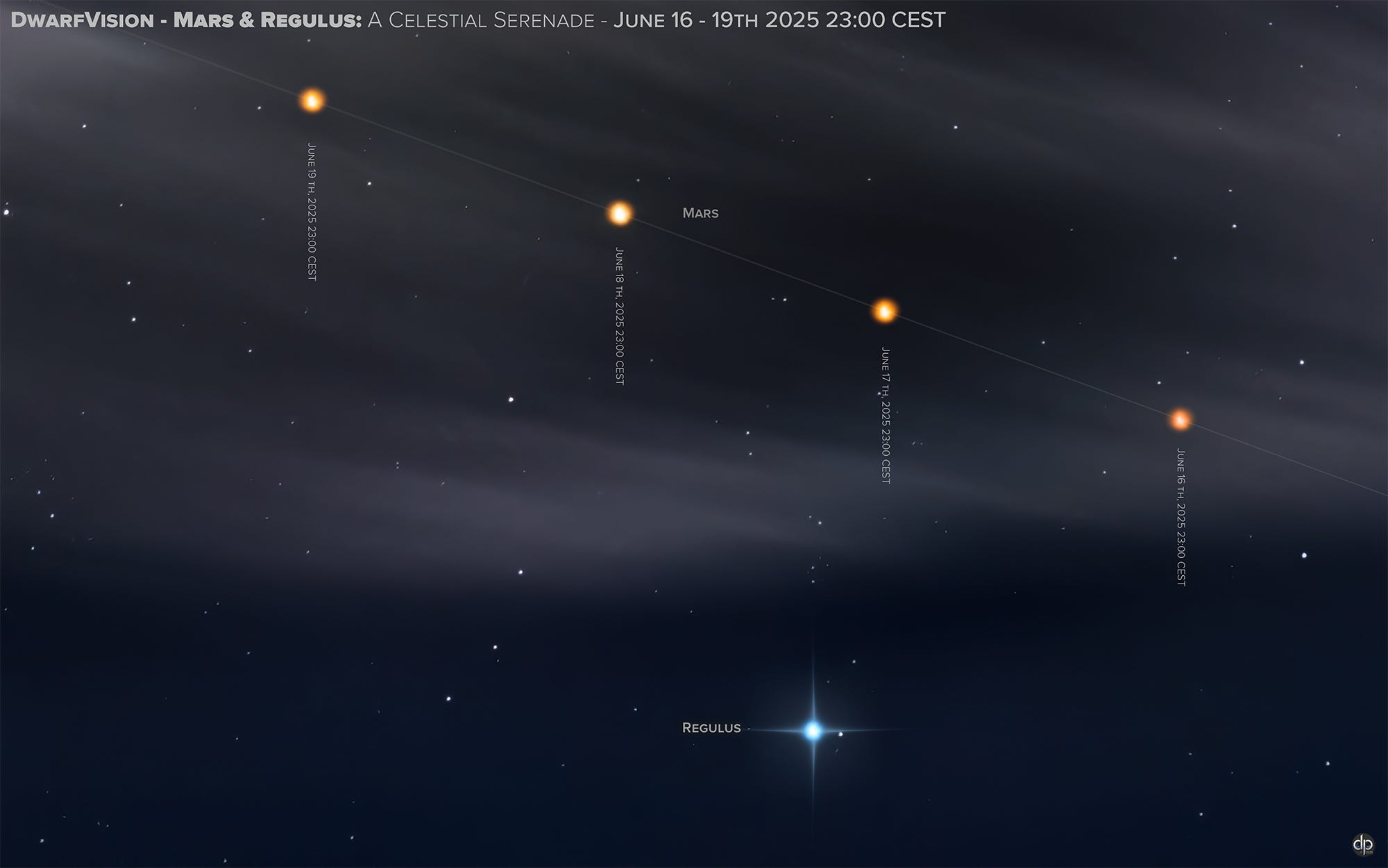
Mars - Our Fiery Neighbor's Dance (The Local View)
Our journey into this celestial serenade begins close to home, with Mars. This captivating ruddy red orb, so beautifully colored by the iron oxides on its surface, is a familiar and enticing presence in our night sky. From June 16th to 19th, 2025, Mars's orbital motion tracked it southeastward across our sky daily. Observers could observe its apparent daily motion as it danced near Regulus, creating the striking visual alignment depicted in our four-day capture above.
While this apparent movement is fascinating, it's not quick enough to fully counter Earth's faster glide around the Sun. Because of our relative positions and speeds, Mars will continue to sink lower towards the western horizon each evening. By the end of August, it will have dipped below the visible evening sky, effectively hiding from view. But fear not, for the Red Planet is set to return! We won't have to wait long, as it's projected to emerge once more on the sunrise side, greeting us as a morning star by November-December 2025, ready for new observations.
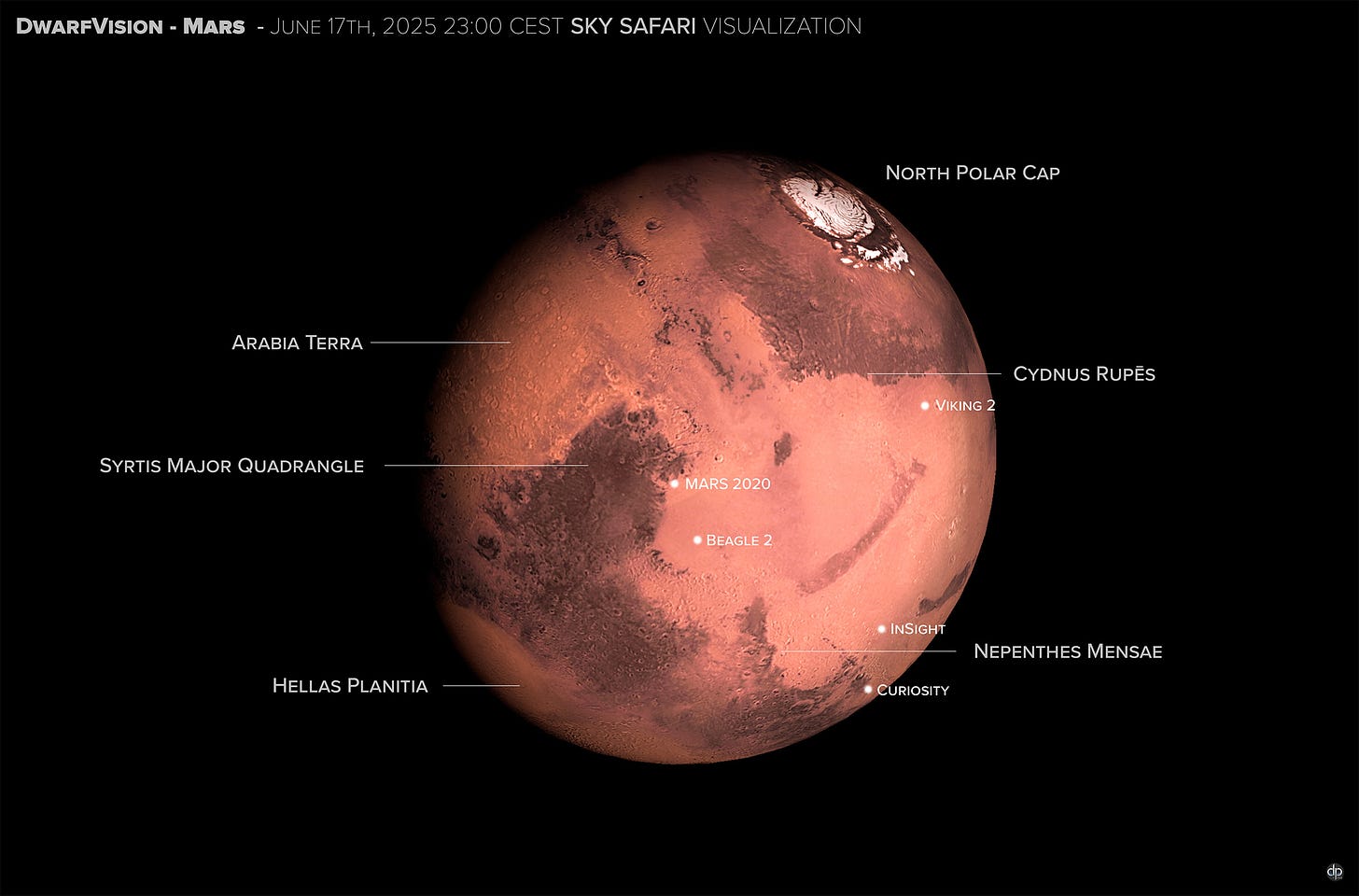
The Blazing Heart of the Lion (Our Galactic Companion)
As Mars performed its daily dance, it aligned with Regulus, the dazzling blue-white heart of the constellation Leo. While Mars is our relatively close solar system neighbour, Regulus exists on a vastly different cosmic scale, a stunning jewel in our Milky Way galaxy.
Regulus is an incredibly hot, massive young star, burning furiously at its core. Though it appears solitary to the unaided eye, this 'Little King' (as Regulus is sometimes known) is a fascinating multiple-star system, with its luminous primary accompanied by at least three fainter companions. Despite its immense distance – approximately 79 light-years from Earth – its subtle proper motion is barely detectable over human timescales, unlike the swiftly moving Mars. This highlights the staggering difference in scale and immensity when comparing a nearby planet to a distant star.
Our recent observation of Mars's 'close approach' to Regulus was a beautiful cosmic alignment from our vantage point in Switzerland. This particular configuration, captured with our D3, offered a unique perspective on the true vastness of space, presenting two objects seemingly close in our sky yet separated by light-years of cosmic distance.
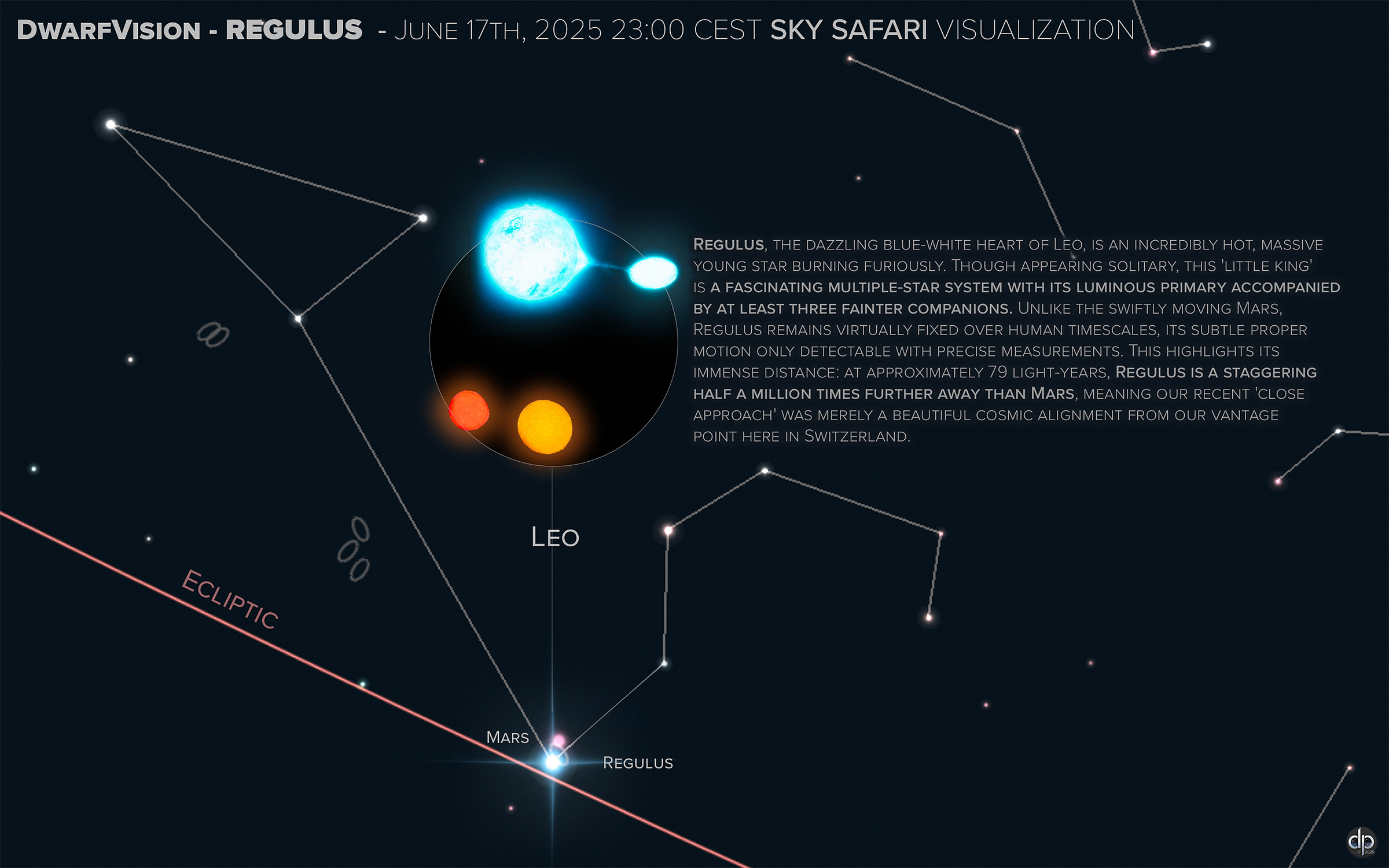
The Distant Echo - Leo I Dwarf Galaxy (Beyond Our Milky Way)
Now, prepare for a true leap into the cosmic deep field. Just beyond Regulus, imperceptible to the unaided eye, lies the faint, ethereal glow of the Leo I Dwarf Galaxy. This fascinating celestial object is a satellite galaxy of our own Milky Way, situated at a breathtaking distance of about 820,000 light-years. It traces a highly elliptical orbit around our galaxy, making it the most distant member of our Local Group of galaxies.
What makes Leo I particularly intriguing, and a prime target for deep sky appreciation through a scope, is its surprisingly massive central black hole. This black hole, estimated to be approximately 3 million solar masses, is nearly as massive as the Milky Way's central supermassive black hole. This disproportionately large black hole, relative to the dwarf galaxy itself, offers unique insights into how black holes grow within smaller galaxies – a cosmic anomaly that continuously fuels our curiosity at DwarfVision.
Observing such a faint and ancient object like Leo I, illuminated by light that has travelled for hundreds of thousands of years, in the same field of view as the much brighter Mars and Regulus, truly showcases the capabilities we champion here at DwarfVision. It connects us directly to the vastness of the universe from our small corner of the cosmos here on Earth, allowing us to simultaneously appreciate our local neighbourhood and the distant edges of our galactic group.
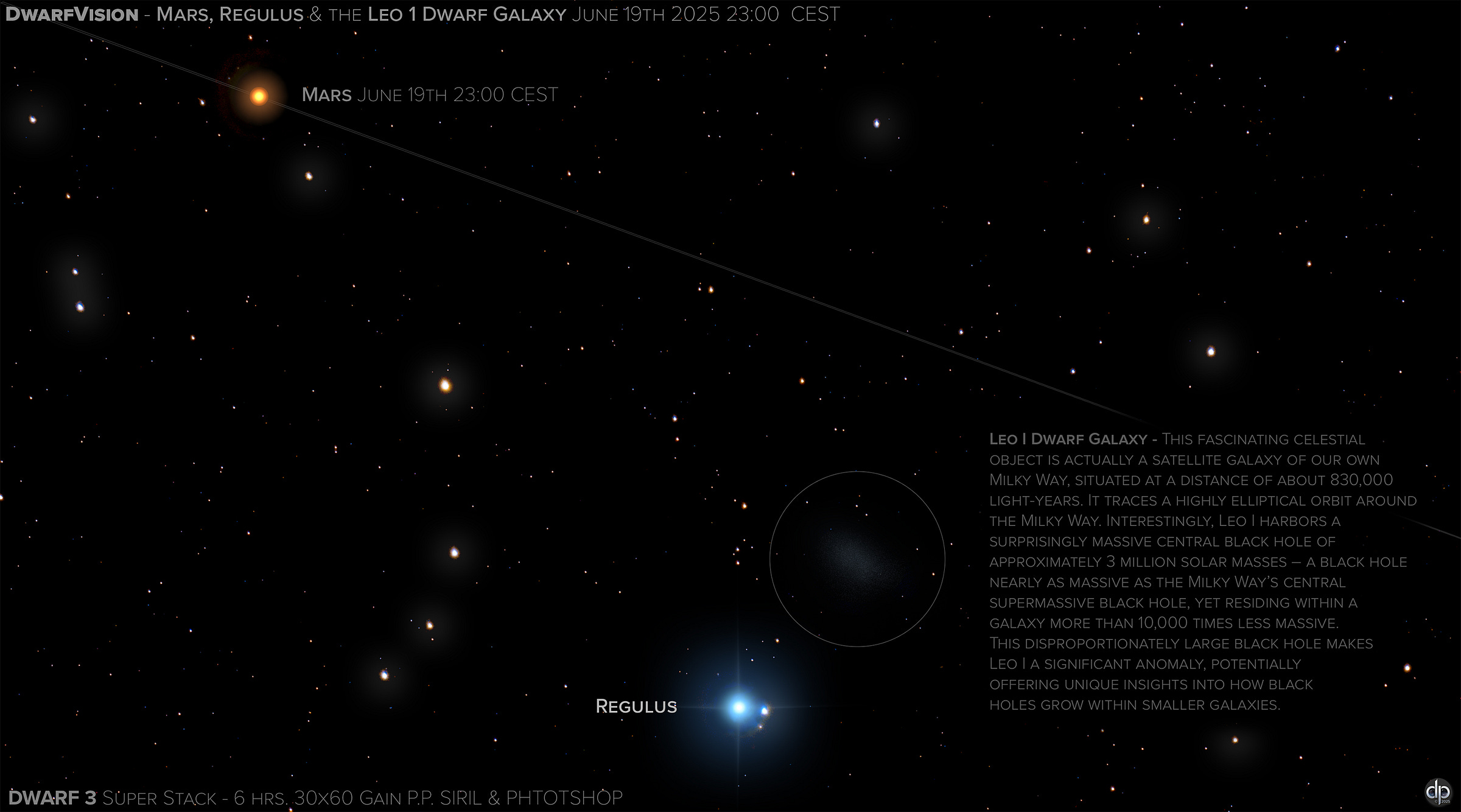
The recent alignment of Mars, Regulus, and the Leo I Dwarf Galaxy was more than just a beautiful astronomical event; it was a profound cosmic symphony. We witnessed our planetary neighbour's vibrant energy, the star's immense power in our galaxy, and the ancient whispers of a galaxy nearing a million light-years away. Such moments offer a rare chance to truly grasp the magnificent scale of our universe, a testament to the dynamic interplay of celestial bodies across unimaginable distances.
DwarfVision CREW Bonsus Poster!
For new paying subscribers and our CREW, download this stunning desktop poster! The link is below in the subscriber section…
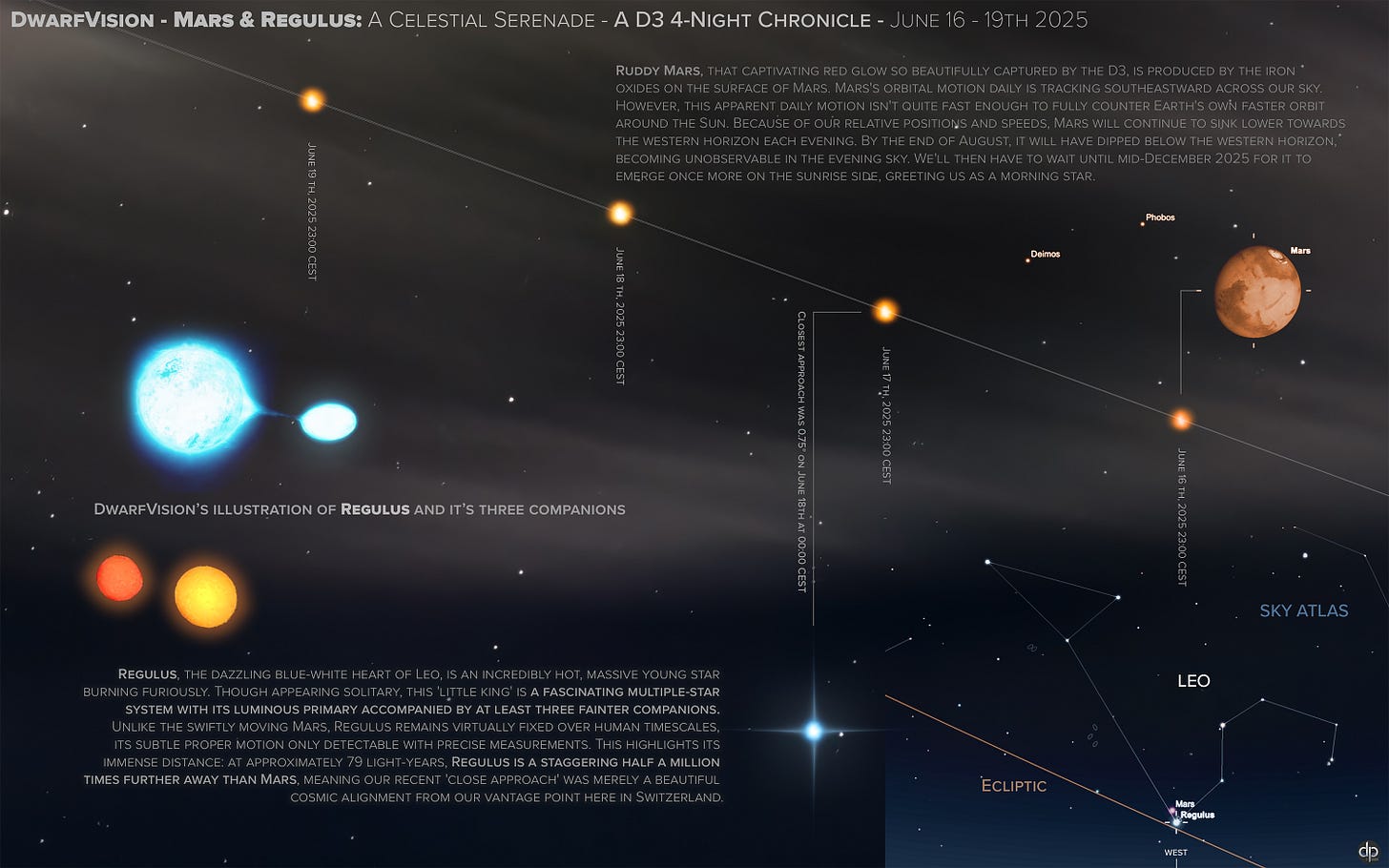
Upcoming Offers from DwarfVision:
The DwarfVision Data Club – Exclusive for The CREW (Coming Soon)
Step into the world of professional astrophotography with the first extensive object database of D3 Deep Sky Objects (DSOs) captured from our dark sky location in Switzerland. Exclusively for DwarfVision CREW, each month you'll gain access to download a featured, high-quality DSO dataset. We also invite a unique collaboration: contribute your own DSOs to this growing database and earn rewards for your participation. Full details on how to join this groundbreaking initiative will be announced soon!
The DwarfVision Store – Unlock the Cosmos (Coming Soon)
Explore a curated collection of individual Deep Sky Objects (DSOs) and complete DSO sets, available for direct download. These high-resolution datasets are perfect for enhancing your own astrophotography captures, practicing image processing techniques, or simply adding breathtaking raw cosmic data to your personal library.
In addition, our store will feature stunning print-on-demand posters, allowing you to bring the beauty of the cosmos directly into your home. Our comprehensive DSO field guides, designed to be your indispensable companion for on-the-go stargazing sessions, will also be available for the avid observer. All products can be purchased and shipped directly to your location worldwide. Stay tuned for the grand opening!
Keep reading with a 7-day free trial
Subscribe to DwarfVision to keep reading this post and get 7 days of free access to the full post archives.




